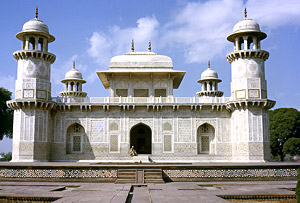 The Itmad-Ud-Daulah tomb is a beautifully ornamented structure built by Jahangir`s Begam Noor Jahan as a memorial of her father Mirza Ghiyas Beg in the city of Agra. Itmad-ud-daula has an unusual place in the records of both history as well as architecture and it is the very first tomb in India that is completely made out of Marble. The tomb has a pietra dura inlay and lattice work in the marble screens. Before Taj Mahal was built, this was the most famous structure in the Agra city. The tomb built in the year 1628, is situated to the North of Agra fort in the bank of the river Yamuna. The Itmad-Ud -Daulah tomb is sometimes referred as baby Taj.
The Itmad-Ud-Daulah tomb is a beautifully ornamented structure built by Jahangir`s Begam Noor Jahan as a memorial of her father Mirza Ghiyas Beg in the city of Agra. Itmad-ud-daula has an unusual place in the records of both history as well as architecture and it is the very first tomb in India that is completely made out of Marble. The tomb has a pietra dura inlay and lattice work in the marble screens. Before Taj Mahal was built, this was the most famous structure in the Agra city. The tomb built in the year 1628, is situated to the North of Agra fort in the bank of the river Yamuna. The Itmad-Ud -Daulah tomb is sometimes referred as baby Taj.
History of Itmad- Ud- Daulah Tomb
Mirza Ghiyas-ud-din or later discerned as Itmad-ud-Daulah was a deprived vendor and lived in Persia. While on his way to India for business, his wife gave birth to a baby girl and as the family was very poor and had nothing to eat, the parents decided to throw out the child. Though, the weeps of the baby girl forced the parents to come back and take her with them. The baby girl brought a stroke of good luck to her parents. In the course of time, Ghiyas Beg rose to become a minister and a trusted treasurer in Akbar`s court. After Akbar`s death in 1605, his son Jahangir became the Mughal emperor, who made Ghiyas Beg his chief minister or Wazir.
Ghiyas Beg`s daughter grew up to be a gorgeous lady and came to be known as Mehr-un-Nissa or the sun of womankind. With the time, the fame of her beauty spread. She was married off, but she soon became a widow. She returned to the court of Jahangir where her father was employed. Emperor Jahangir fell in love with her and married her. She soon became a powerful personality in Jahangir`s court and was called Nur Mahal, the light of the palace, and Nur Jahan, light of the world. When Itmad-ud-Daulah died in 1622, Nur Jahan undertook the project to build his grave. Later she built the tomb of her husband in a similar style in Lahore. Nur Jahan had a brother whose daughter was married to Jahangir`s son, Shahjahan. She was known as Mumtaz Mahal in whose memory Shahjahan built the world famous Taj Mahal.
Architecture of Itmad- Ud- Daulah Tomb
The Itmad-Ud-Daulah tomb is quite different from the other Mughal structures in terms of architecture. The sight of the tomb is fascinating even it was not as big as Taj Mahal. The mausoleum is set on a base about 50 meters square and 1 meter high. The tomb is a square structure of about 23 meters. On each corner of the tomb, there are hexagonal towers, each about 13 meters tall.
Itmad- Ud- Daulah TombMirza Ghiyas himself laid out the `Char Bagh`(meaning four gardens) style of architecture of the tomb six years before his death. The beauty of the white marble with the mosaic and the lattice is very pleasant to the eyes of beholders. The tomb structure has a minaret on each of its four corners. The walls of this cenotaph are inlaid with marvelous illustrations. Especially the cypresses and geometrical designs are engrossing. The walls of the chambers contain a recurrent theme of wine flasks with the snakes as handles, also images of cut fruits or bouquets of flowers on a vase. Light to the interior, passes through delicate jali screens of intricately carved white marble. The adjacent chambers to the main chamber have the tombs of other members of the family. The monuments of Mirza Ghiyas and his wife lie side by side. The main chamber of Itmad-Ud-Daulah tomb is ornamented with semiprecious stones like cornelian, lapis lazuli, jasper, onyx, topaz etc inlaid on the mosaics. The decoration follows the style of Indian version of Pietra Dura and is quite different from that of Europe. The grave is set in the centre of a large cruciform garden criss-crossed by waterways and walkways.



